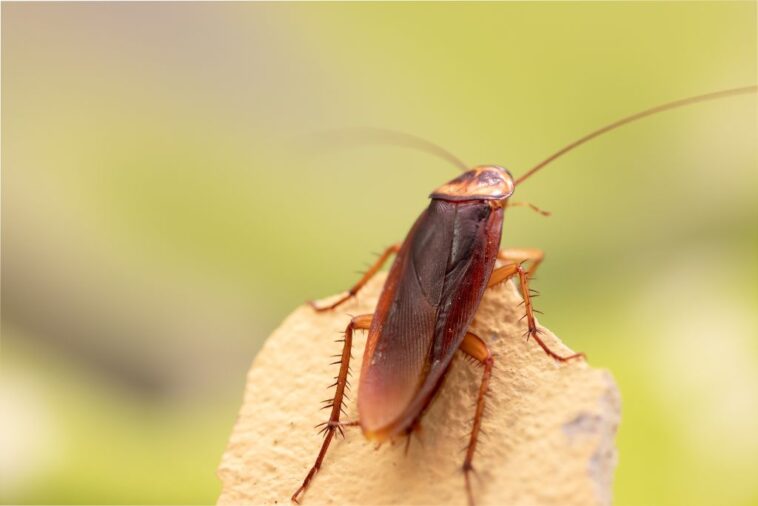Dealing with a cockroach infestation, especially when these pests have developed wings and can fly, can be a daunting task. Flying cockroaches pose a significant nuisance and potential health risks, as they can contaminate food and surfaces with their droppings. To effectively eliminate these unwanted visitors, a comprehensive approach is necessary.
Step 1: Start Outside
Before tackling the problem indoors, it’s essential to address any potential entry points and breeding grounds outside your home.
- Locate and seal any cracks, gaps, or openings in the exterior walls, roof, and basement that could serve as entry points for cockroaches using caulk or sealant.
- Apply a long-lasting insecticide (e.g., products containing deltamethrin or lambda-cyhalothrin) around the perimeter of your home, focusing on areas where cockroaches are likely to enter or nest, such as around foundations, vents, and utility lines.
- If you have a shed or other outbuildings on your property, treat these areas as well, as cockroaches can easily travel between structures.
Step 2: Tackle the Interior
Once you’ve addressed the exterior, it’s time to turn your attention to the inside of your home.
- Identify potential hiding spots and breeding grounds for cockroaches inside your home, such as kitchen cabinets, behind appliances, under sinks, and in dark, undisturbed corners.
- Apply a residual insecticide spray (e.g., products containing cypermethrin or bifenthrin) along baseboards, around pipes, and in other potential harborage areas. Follow the product instructions carefully and avoid spraying directly on food preparation surfaces or open food containers.
- Use caution when spraying in areas where children or pets may come into contact with the treated surfaces.
- For hard-to-reach areas or heavily infested spots, consider using insecticidal dusts or gels, which can be applied directly into cracks, crevices, and other tight spaces where cockroaches may be nesting.

Step 3: Bait and Monitor
Baiting is an effective method for controlling cockroach populations, especially when combined with other treatments.
- Locate areas where cockroaches are active and place bait stations or apply gel baits in these locations, such as behind appliances, under sinks, and along baseboards.
- Use products containing insecticides like fipronil, hydramethylnon, or indoxacarb, which are effective against cockroaches.
- Monitor the bait stations regularly and replace them as needed, following the manufacturer’s instructions.
Step 4: Maintain Vigilance
Even after an initial treatment, it’s essential to remain vigilant and follow up with additional measures to prevent a recurrence of the infestation.
- Eliminate any potential food and water sources for cockroaches by keeping your home clean and dry. Store food in airtight containers, promptly clean up spills, and fix any leaks or moisture issues.
- Vacuum and sweep regularly to remove any crumbs or debris that could attract cockroaches.
- Repeat the insecticide treatments and baiting as needed, typically every 3-6 months or as recommended by the product manufacturer.
- If the infestation persists or is particularly severe, consider hiring a professional pest control service for more extensive treatment.
Step 5: Treat Other Areas
In some cases, cockroaches may have established themselves in other areas beyond your home, such as vehicles or garages.
- If you suspect cockroaches in your car, treat it by vacuuming thoroughly, applying insecticide sprays or dusts in crevices and under seats, and using bait stations or gels in appropriate locations.
- Garages, sheds, and other outbuildings should also be treated with insecticides and baits if cockroach activity is observed in these areas.
Dealing with Encountered Flying Cockroaches
If you encounter a flying cockroach in your presence, it’s essential to act quickly and decisively:
- Use a flat object like a book, magazine, or piece of cardboard to trap the flying cockroach against a wall or surface, preventing it from escaping.
- If you have an insecticide spray handy, spray the cockroach directly. Aerosol sprays containing pyrethrins or pyrethroids are effective in killing cockroaches on contact.
- If you can trap the cockroach, carefully slide a container (like a glass or plastic jar) over it and secure it with a piece of cardboard or paper before disposing of it by flushing it down the toilet or placing it in a sealed bag.
- You can also use a vacuum cleaner with a hose attachment to suck up the flying cockroach if it lands on a surface.
- As a last resort, you can try to step on or squash the cockroach with a shoe or a heavy object, but be cautious as cockroaches can release unpleasant odors and bodily fluids when crushed.
- If the situation proves too difficult to handle on your own, don’t hesitate to call for assistance from family members or a professional pest control service.
Remember, encountering a single flying cockroach often indicates a larger infestation, so it’s crucial to follow up with a thorough inspection and treatment of your home to eliminate any potential breeding grounds and prevent future infestations.
By following this comprehensive approach and remaining vigilant, you can effectively eliminate flying cockroaches from your home and maintain a pest-free and healthier living environment for you and your family.



GIPHY App Key not set. Please check settings